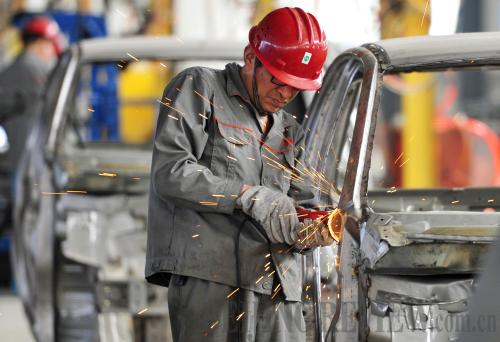|
 |
|
SPARKS FLY: A worker operates on a production line in a factory in Botou, Hebei Province (YANG SHIYAO) |
Large enterprises and quality medium-sized enterprises will gain more leverage in bargaining with banks and their financing costs will be reduced now that the floor is removed, says Lian, which will help keep economic growth stable. Furthermore, banks would like to grant more credit to small and micro-sized enterprises at higher interest rates, alleviating their lack of resources. Since small and micro-sized enterprises play a bigger role in promoting employment, economic growth and transformation will be boosted.
The country's traditional economic growth model cannot continue, and a liberalizing of interest rates is therefore necessary. Because of strict interest rate controls, commercial banks have been relying on easy credit and the interest gap between loans and deposits. There was no impetus to improve their management and services; most domestic credit resources went to state-owned enterprises.
A gradual easing of interest rates was urgently needed to solve these problems, curb irrational credit demand and send credit to business and entities that support the real economy. The central bank's removal of the lending rate floor complies with the need.
Lian says removing the floor will play a significant role in three aspects. It will promote the innovation of commercial banks. Now that the floor is removed, the interest income of commercial banks may be reduced, forcing them to innovate and create non-interest-based income.
Supervision will become more scientific. Through changes in borrowing and lending rates and the prices of other financial tools, the central bank can make a more accurate judgment on the supply and demand of funds and whether asset allocation is balanced, which are all important indicators for the central bank's monetary policy decisions.
It will also alleviate the difficulties in securing financing faced by small and micro-sized enterprises. Competition between banks will be increasingly fierce to nab small and micro-sized enterprises with higher interest rates on loans.
Next step
With the floor on the lending rate now gone, China is only one step away from fully liberalized interest rates. The next step is to remove the ceiling on deposit rates, a change that will have a greater impact on the country's banking industry. Lifting that ceiling must be done in a step-by-step and orderly way, say analysts.
Unlike in developed economies, China lacks a fully functioning deposit insurance system, for one, which would guarantee depositors a certain portion of deposits should a bank go bust. Until one is in place, removing the ceiling on deposit rates won't happen.
China is also learning from history. In the 1970s when the United States removed deposit rate controls, thousands of banks went bankrupt, something the Central Government can't tolerate in China. Opening up deposit rates is considered the most crucial yet risky step in liberalizing interest rates.
Industrial insiders say the central bank could remove the ceiling on deposit rates within five years after assessing the impact of liberalizing lending rates on the banking sector.
Email us at: lanxinzhen@bjreview.com
Pace of Interest Rate Reform
1996: Interbank borrowing rate controls are removed.
2004: Lending rate ceiling is removed.
June 2012: The PBC sets the ceiling for the deposit interest rate at 1.1 times that of the benchmark rate, and the floor for the interest rate on loans at 70 percent of the benchmark.
(Compiled by Beijing Review) | 